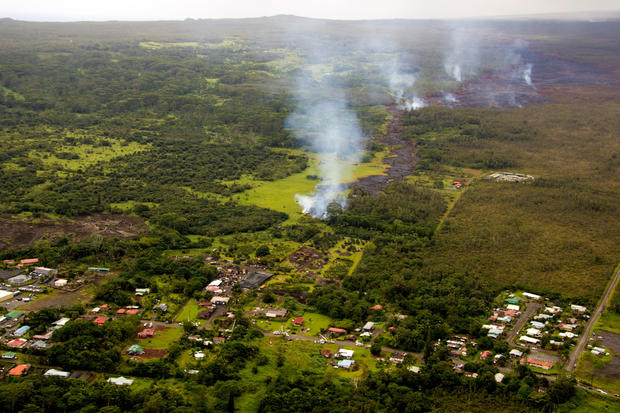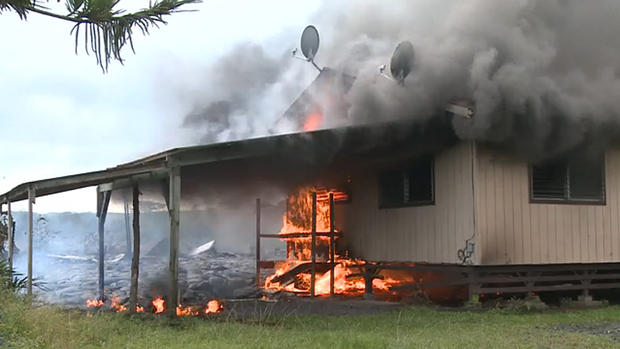Hawaii lava flow: Slow-motion disaster may come with explosions
PAHOA, Hawaii - As a molten lava flow continues to create a slow-motion disaster on the Big Island of Hawaii, residents are being allowed to watch their homes burn despite the possible danger of explosions from methane and oxygen buildup underground.
In an attempt to help residents find some closure, officials are allowing people to witness the lava destroy their houses, reports CBS News correspondent Carter Evans.
"They're obviously very sad because they love where they live," said Hawaii County Civil Defense Directorr Darryl Oliveira. "But for them like many other people life is changing and they're just adapting to it as this continues to unfold because it is a life changing event."
The lava flow began in June after the eruption of the Kileauea Volcano and is now about 280 yards from one of the main roads in the village of Pahoa, and is moving at a speed up to 15 yards per hour. The lava advanced about 90 yards since Tuesday evening.
Pahoa is the commercial center of Puna, a sprawling, mostly agricultural and forested part on the Big Island.
CBS affiliate KGMB in Honolulu reports an estimated 40-50 homes currently sit in the flow's path.
People here have had weeks to prepare, but still find themselves overwhelmed.
"The impact is going to be severe," said Lani Kaawaloa, a Pahoa resident. "Already if you drive on the back road it's bumper to bumper traffic. Just because all of this is happening. Once she crosses the road. I know it's going to be mayhem."
With temperatures nearing 2,000 degrees, geologist warn of the dangerous mix forming between the intense heat and gas from the lava flow.
"In this situation what's happening is that gas is mixing in underground caverns and when it gets to a certain percentage of oxygen and methane ratio and with the heat from the lava flow it ignites and it explodes," said Kevan Kamibayashi with the U.S. Geological Survey.
Jeff and Denise Lagrimas' single-story home is just across the street from properties where the lava is expected to slither past on its way to the ocean.
But they're moving to another town 14 miles away before they're able to find out whether this forecast comes true or whether the molten rock oozes into their home instead.
"I don't want to stick around and just wait for it to come and take it," Denise Lagrimas said while taking a break from loading kitchen cups and bowls in cardboard boxes. "You just never know."
The lava entered private property next to the main road and was burning tires and other materials. This prompted authorities to warn downwind residents with respiratory problems to stay indoors.
Earlier Tuesday, the lava burned down an empty shed.
The lava picked up speed last week after weeks of slow, stop-and-go movement. It broke out of forest and pastureland and crossed into inhabited areas for the first time since scientists began warning about lava in August.
At least 50 or 60 structures - including homes and businesses - are in an area civil defense officials are currently warning will likely be hit.
Josiah Hunt, who has a farm in a part of Puna that is not immediately threatened, described smelling burning grass, feeling warmth from the lava and hearing "popping and sizzling and all the methane bursts that are happening in the distance ... mixed with the birds chirping and the coqui frogs."
The Lagrimas family decided to move to Kurtistown, a safe distance from Kilauea's current flow.
"We didn't want to go anywhere where it's close enough where we would have to evacuate again," she said.
The Lagrimases are also worried the lava will block roads leading out of Pahoa and prevent them from commuting to their jobs in Hilo. Then there's the prospect of subsequent flows gradually swallowing more of the community, which is what happened to the Royal Garden and Kalapana subdivisions in the 1980s and 1990s.
"It's so surreal, it's so surreal. Never in my wildest dreams as a kid growing up did I think I would be running from lava," said Denise Lagrimas.
Some people want to watch the lava destroy their homes as it's one way to cope with the loss.
"You can only imagine the frustration as well as ... despair they're going through," said Civil Defense Director Oliveira.
Hunt watched last week as the lava crept toward Pahoa and saw a woman whose house is near its path put a lei at the front of the flow. "It helps a person come to grips with the reality of the situation," he said. "I found it to be oddly comforting in a really strange way."
Terri Mulroy, who runs Kumu Aina Farm with her husband, said the lava flow, while unnerving, has a cleansing quality to it because it keeps development on the lush Hawaiian island in check.
"If it wasn't for the flow, I wouldn't be able to live here," she said. "This land would have been a golf course for the rich."


